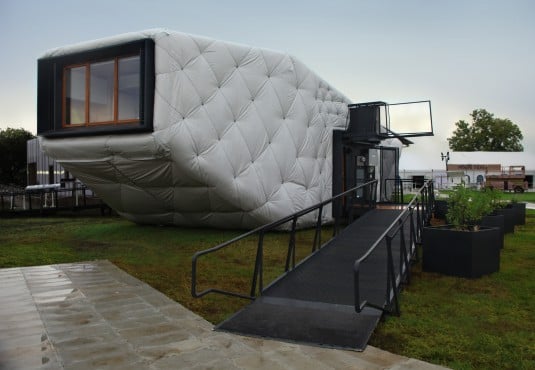
September 28, 2011
An Opportunity for Innovation
Photo: Darius Siwek CHIP (Compact, Hyper-Insulated Prototype) is a new architectural proposition for sustainable housing. It uses the platform of the Solar Decathlon (through October 2) to disseminate big ideas to a wide audience. Developed over two and a half years, the project is a result of a unique collaboration between two schools, each on […]
Photo: Darius Siwek
CHIP (Compact, Hyper-Insulated Prototype) is a new architectural proposition for sustainable housing. It uses the platform of the Solar Decathlon (through October 2) to disseminate big ideas to a wide audience. Developed over two and a half years, the project is a result of a unique collaboration between two schools, each on the leading edge of their respective fields of Architecture and Engineering. Students from the Southern California Institute of Architecture (SCI-Arc) and the California Institute of Technology (Caltech) have learned to speak each other’s language in a generative effort to create a truly innovative home that furthers the discourse of green-tech housing.
CHIP has three primary objectives:
1- Design a house that is compact with a small footprint to sit within small and odd plots found around Los Angeles. This strategy speaks to the need for densification in a city known for its sprawl, while reducing the overall cost of the dwelling as well as the land.
2- Implement a first-of-its-kind hyper-insulated building shell that rethinks traditional insulation methods. CHIP’s exterior insulation strategy, termed “outsulation”, wraps the building in a continuous R-45 blanket of insulation made out of recycled blue jeans. While not typically considered a design feature, insulation is a critical component to achieving a net-zero home. Enveloping the outsulation is a flexible, seamless wrap that covers the house like a glove. The resulting aesthetic is that of a spacesuit, with performance driving the visual.
3- Inspired by the traditional of innovation at both schools, we decided to develop the building as a prototype. By categorizing the building in this way, we are declaring that this is a new proposition for green design ideas. We do not expect this home to be scaled by the millions. We believe that this competition is a unique opportunity to manifest big ideas into built form so that they will disseminate to an international audience.
How CHIP shuffles the affordability deck. The technologies present in CHIP are attainable and marketable today, yet they incorporate innovations that allude to the future. By using common building materials in extraordinary new ways, CHIP gets results at an affordable price. Things have not always been this way.
It has been a common assumption that great design, and most recently green design, is accompanied by an inevitably high price tag. This assumption focuses on the laundry list of retrofitted green products and technologies that must be added to a standard home design. Under this equation, green design will never attain a foothold in the economic climate of today. These retrofitted products will always be the first things subtracted when value engineering strikes.
CHIP incorporates big, green ideas into the home by shuffling them into a holistic proposition of affordable, sustainable housing. Examples of this include:
-A unique architectural form that maximizes user experience within a small footprint, resulting in a small home that lives big. CHIP functions like a house twice its size at the same price.
-Type-V wood-framed construction that can be built by a contractor out of the back of a truck. We contend with the assumption that a builder can only build a box and a gable. Our team meets the builder halfway by making this unique shape buildable to the people that build them.
-A unique engineering design that balances the energy draw of appliances, plumbing, electrical and HVAC systems in order to dramatically reduce the overall energy demand of the building. This system is small, nimble and affordable; allowing a bit of breathing room to design the architecture around it.
-The use of conventional, off-the-shelf materials in extraordinary ways. No material or piece of equipment in CHIP is foreign to building construction. It is in the application of these materials that all innovation lies. The materials are familiar, but the application makes them fresh.
 Photo: Darius Siwek
Photo: Darius Siwek
We are proud to tell you that just yesterday we were awarded 3rd place in the affordability contest. CHIP came in at a final price tag of $262,000 (Materials and Labor). This is a powerful statement that smart architecture and sound engineering can make innovation attainable.
What’s the take-away? CHIP is a collection of big ideas. It can be evaluated as a whole or analyzed for the innovation of its components. Either way, it proposes a change in the trajectory of green building by showing the public that sustainable design has room to grow. We are only beginning to see the true potential of this bourgeoning movement for homes that are affordable, energy efficient, and well designed. CHIP does all this while adding a refreshing element that is often lost in this discussion: Fun.
Reed Aspen Finlay, Project Manager of the SCI-Arc/Caltech the 2011 Solar Decathlon Team, received his M. Arch I in September 2010.





